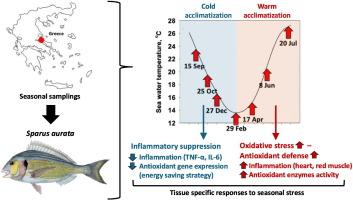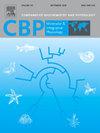季节性对黄颡鱼(Sparus aurata)炎症和抗氧化反应的影响
IF 2.2
3区 生物学
Q4 BIOCHEMISTRY & MOLECULAR BIOLOGY
Comparative Biochemistry and Physiology A-Molecular & Integrative Physiology
Pub Date : 2025-09-30
DOI:10.1016/j.cbpa.2025.111938
引用次数: 0
摘要
地中海鱼类,如Sparus aurata,受到气候变化影响的极端高温和低温的影响,导致氧化应激和炎症反应增加。为了探索这些现象,我们评估了TNF- a和nfkb基因表达以及TNF-α和IL-6水平与炎症的关系,同时测量了sod、cat和gr基因表达以及sod、gr和过氧化氢酶活性水平,以评估抗氧化反应。结果显示不同的组织特异性反应,将适应阶段分为不同的冷和暖模式。在高血管性组织(心脏和红肌)中,随着海水温度的升高,炎症水平增加,突出了季节性的强烈氧化作用,这种氧化作用不能通过增加抗氧化酶反应来改善。然而,在此期间,抗氧化基因表达的减少可能突出了能量分配过程,而不是抗氧化防御。白色肌肉和肝脏则表现出相反的模式,遵循温度模式,随着温度的降低,水平降低,可能在温度降低时表现出代谢抑制,而在升温时表现出增加趋势(主要涉及抗氧化防御)。这些变化揭示了鱼类对季节性温度波动的适应性反应,以及暴露于季节性环境氧化应激时潜在的热耐受机制。了解这些反应有助于科学家了解鱼类如何应对与气候有关的压力,这对于在变暖的世界中管理鱼类种群和支持可持续水产养殖非常重要。本文章由计算机程序翻译,如有差异,请以英文原文为准。

Seasonality effects on the inflammatory and antioxidant responses in the gilthead seabream (Sparus aurata)
Mediterranean fish such as Sparus aurata are subjected to extremes of high and low temperature favored by climate change effects, resulting to increased oxidative stress and inflammatory responses. To explore these phenomena, tnf-a and nfkb gene expression, as well as TNF-α and IL-6 levels were evaluated regarding inflammation, while sod, cat and gr gene expression, as well as SOD, GR and catalase activity levels were measured to assess antioxidant response. Findings revealed distinct tissue specific responses, dividing acclimatization phase into distinct cold and warm patterns. In highly vascular tissues (heart and red muscle) increased inflammatory levels were observed at increasing sea water temperatures, highlighting seasonality's strong oxidative effect, which cannot be ameliorated by the increased antioxidant enzymatic response. However, the decreased expression of the antioxidant genes during this period probably highlights energy allocation for processes other than antioxidant defense. An opposite pattern was exhibited in the white muscle and the liver, following the temperature pattern, with lowering levels with decreasing temperatures, probably showing a metabolic depression during decreased temperatures, and an increasing trend (mostly regarding antioxidant defense) during warming. These adjustments enlighten the adaptive responses of fish which reflect fluctuations of seasonal temperature, and the underlying thermal tolerance mechanisms during exposure to seasonal environmental oxidative stress. Understanding these responses helps scientists learn how fish cope with climate-related stress, which is important for managing fish populations and supporting sustainable aquaculture in a warming world.
求助全文
通过发布文献求助,成功后即可免费获取论文全文。
去求助
来源期刊
CiteScore
5.00
自引率
4.30%
发文量
155
审稿时长
3 months
期刊介绍:
Part A: Molecular & Integrative Physiology of Comparative Biochemistry and Physiology. This journal covers molecular, cellular, integrative, and ecological physiology. Topics include bioenergetics, circulation, development, excretion, ion regulation, endocrinology, neurobiology, nutrition, respiration, and thermal biology. Study on regulatory mechanisms at any level of organization such as signal transduction and cellular interaction and control of behavior are also published.

 求助内容:
求助内容: 应助结果提醒方式:
应助结果提醒方式:


